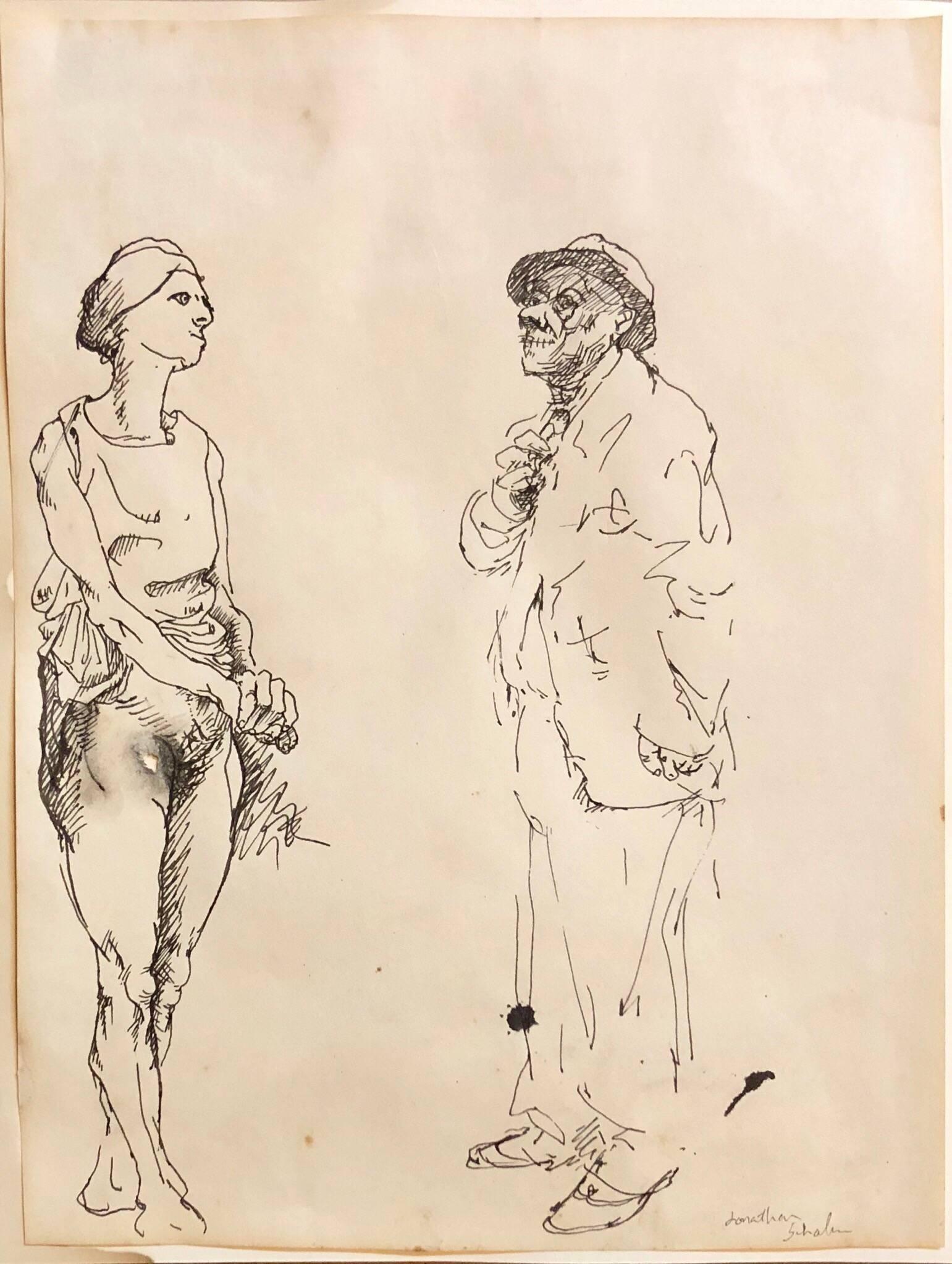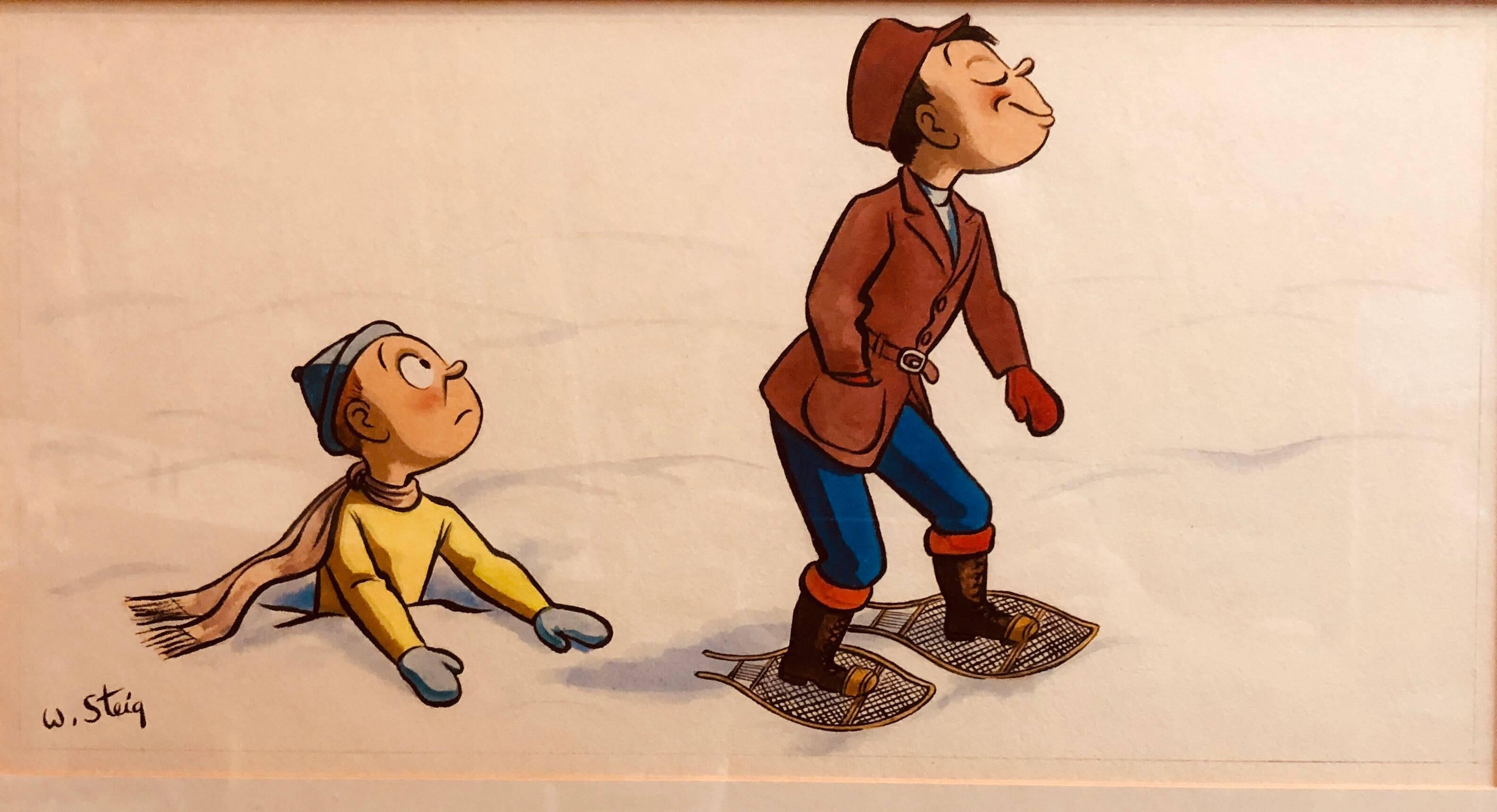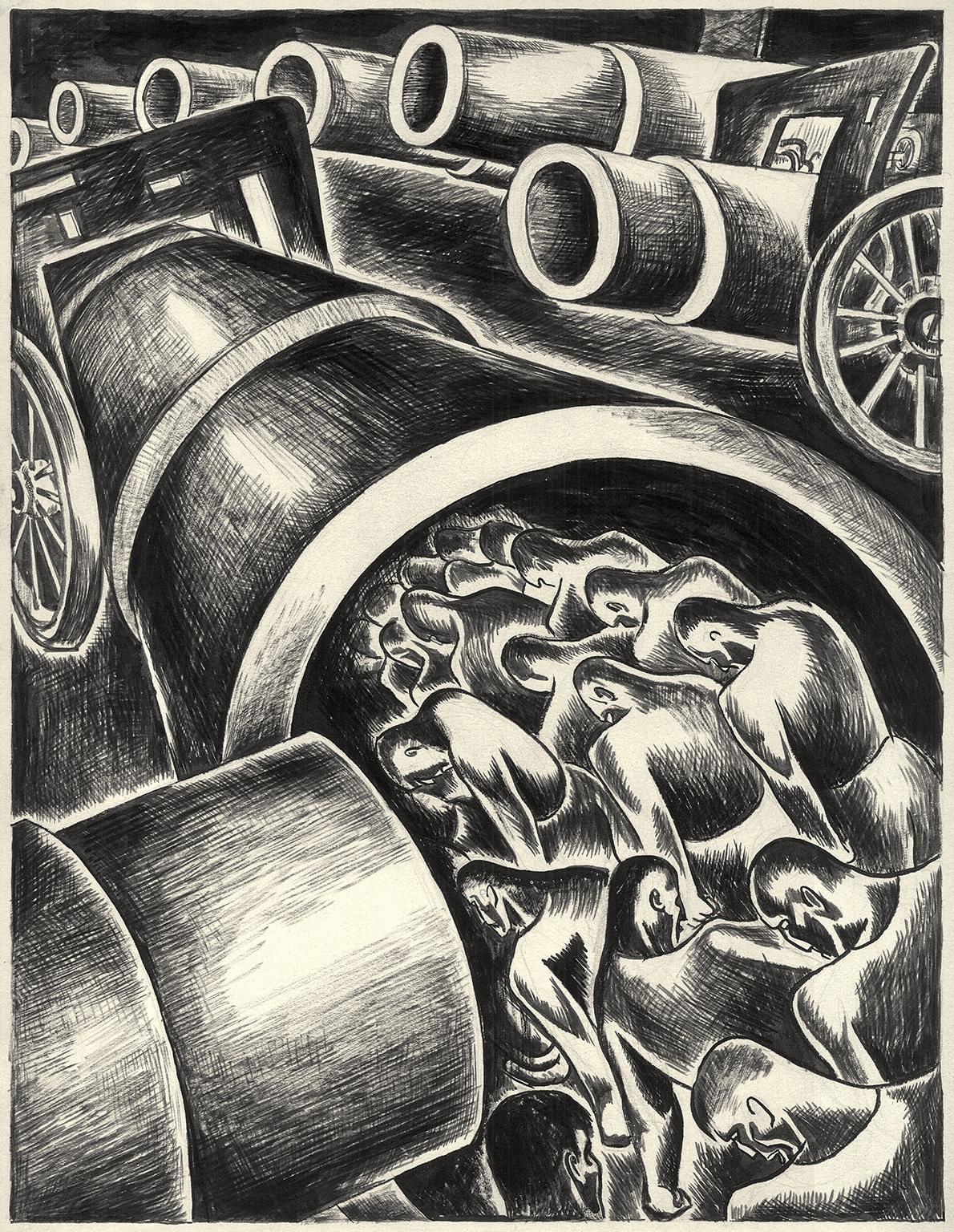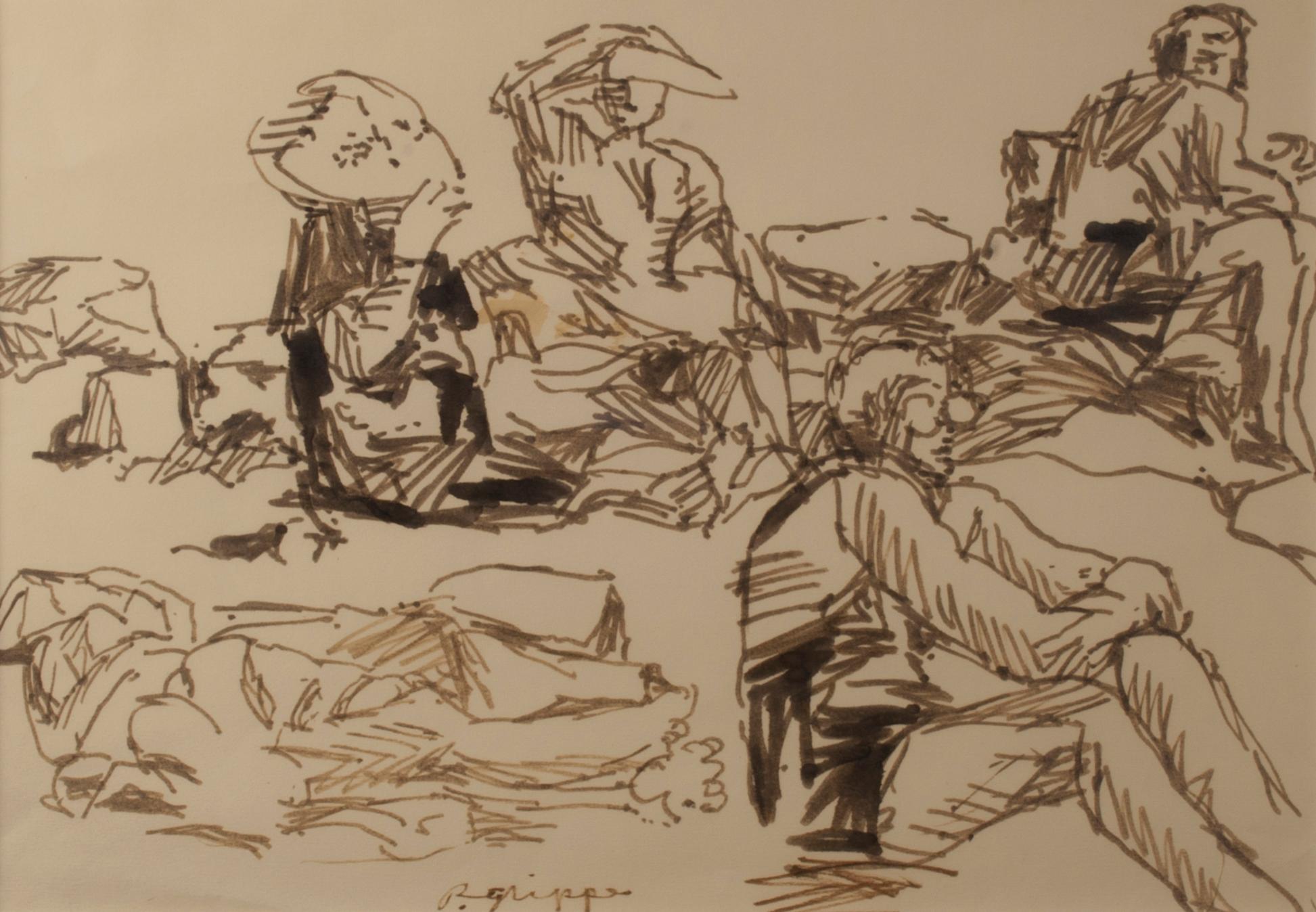Leon BibelDeath March — Spanish Civil War, Anti-fascismc. 1936
c. 1936
About the Item
- Creator:Leon Bibel (1913 - 1995)
- Creation Year:c. 1936
- Dimensions:Height: 12.32 in (31.3 cm)Width: 9.38 in (23.83 cm)
- Medium:
- Movement & Style:
- Period:
- Condition:
- Gallery Location:Myrtle Beach, SC
- Reference Number:
Leon Bibel
Leon Bibel, a painter, printmaker and sculptor, was born in Poland in 1913 but moved with his family to San Francisco as a child. He trained at the California School of Fine Arts and received a scholarship to study under the German Impressionist Maria Riedelstein. He worked in collaboration with Bernard Zackheim, a student of Diego Rivera, to create frescoes for the San Francisco Jewish Community Center and the University of California Medical School. In 1936, Bibel moved from California to join the Federal Art Project of the New York City Work Projects Administration. He was assigned to the Graphic Art Project and the Easel Project at Harlem Art Center. He also taught at both PS 94 Kings College School and Bronx House in New York City. Bibel’s program in the WPA ended in 1941 and he moved with his wife to South Brunswick, New Jersey, ceasing his artistic pursuits to support his family. He resumed his artistic work in the early 1960s and continued to explore the mediums of painting and sculpture until his death. A constant innovator, Bibel experimented with diverse printmaking mediums. His work is distinguished by its boldly conceived, dramatic composition and passionately executed expressionist renderings. Bibel's parents immigrated from Poland and he remained staunchly pacifist, even throughout WWII. Much of his work during this period focused on the destructiveness of war and the consequent suffering and alienation of humankind. An artist of the people, his work is imbued with a sense of humanity and a concern for social justice and the plight of the working man. Bibel’s numerous exhibitions include the solo exhibition at Newark Museum in 1966, Jersey City Museum in 1967, Hunterdon Art Museum, Rutgers State University and New Jersey State Museum in 1978. He has also exhibited at Rider College, in 1983, Rutgers Hillel Foundation from 1985–86. His work is held in the permanent collections of the Metropolitan Museum of Art, the Museum of Fine Arts in Boston, the Newark Museum, the Zimmerli Art Museum of Rutgers, the Amon Carter Museum of American Art, the Klutznick Museum and the New Brunswick State Theater, as well as many corporate and private collections.
- ShippingRetrieving quote...Ships From: Myrtle Beach, SC
- Return PolicyA return for this item may be initiated within 7 days of delivery.
- War Machine — Spanish Civil War, Anti-fascismBy Leon BibelLocated in Myrtle Beach, SCLeon Bibel, 'Untitled (War Machine)', brush and ink, c. 1936. Estate stamped, verso. A fine expressionist rendering, on cream wove drawing board, with marg...Category
1930s American Modern Figurative Drawings and Watercolors
MaterialsInk
- Untitled (Figurative Abstraction of Isadora Duncan #7)By Abraham WalkowitzLocated in Myrtle Beach, SCAbraham Walkowitz, Untitled (Figurative Abstraction of Isadora Duncan #7), pencil, 1918. Signed and dated in pencil, bottom center. A fine, spon...Category
1910s American Modern Figurative Drawings and Watercolors
MaterialsPencil
- The Ruby RBy William ThonLocated in Myrtle Beach, SCWilliam Thon, 'The Ruby R', watercolor, c. 1990. Signed, lower right; titled verso. A fine, expressionist work, on off-white watercolor paper; the image extending to the sheet edges....Category
1950s American Modern Figurative Drawings and Watercolors
MaterialsWatercolor
- AlongsideBy William ThonLocated in Myrtle Beach, SCWilliam Thon, 'Alongside', watercolor, c. 1990. Signed, lower right; titled verso. A fine, expressionist work, on off-white watercolor paper; the image extending to the sheet edges, ...Category
1950s American Modern Figurative Drawings and Watercolors
MaterialsWatercolor
- Tourists — vintage drawing, original 'Superman' artistBy Leonard NowakLocated in Myrtle Beach, SCLeonard Nowak, 'Tourists', conté crayon and India ink, c. 1940s. Signed in ink, lower left. Original cartoon drawing, on textured, off-white wove drawing...Category
1940s Modern Figurative Drawings and Watercolors
MaterialsIndia Ink, Conté
- The Thinker? —vintage drawing, original 'Superman' artistBy Leonard NowakLocated in Myrtle Beach, SCLeonard Nowak, 'The Thinker?', conté crayon and India ink, c. 1940s. Signed in ink, lower left. Original cartoon drawing, on textured, off-white wove dra...Category
1940s Modern Figurative Drawings and Watercolors
MaterialsIndia Ink, Conté
- RoseBy Andy WarholLocated in Toronto, OntarioAndy Warhol is arguably the most important American artist of the 20th century. In the 1950s, he was an in-demand and celebrated illustrator working for New York's toniest publicatio...Category
1950s American Modern Figurative Drawings and Watercolors
MaterialsInk, Graphite, Paper
- Whimsical Fishing Illustration Cartoon 1938 Mt Tremblant Ski Lodge William SteigBy William Steig (b.1907)Located in Surfside, FLLighthearted Illustration of Outdoor Pursuits This one of a fisherman signed "W. Steig" Provenance: from Mrs. Joseph B. Ryan, Commissioned by Joe Ryan for the bar at his ski resort, Mount Tremblant Lodge, in 1938. Mont Tremblant, P.Q., Canada Watercolor and ink on illustration board, sights sizes 8 1/2 x 16 1/2 in., framed. In 1938 Joe Ryan, described as a millionaire from Philadelphia, bushwhacked his way to the summit of Mont Tremblant and was inspired to create a world class ski resort at the site. In 1939 he opened the Mont Tremblant Lodge, which remains part of the Pedestrian Village today. This original illustration is on Whatman Illustration board. the board measures 14 X 22 inches. label from McClees Galleries, Philadelphia, on the frame backing paper. William Steig, 1907 – 2003 was an American cartoonist, sculptor, and, in his later life, an illustrator and writer of children's books. Best known for the picture books Sylvester and the Magic Pebble, Abel's Island, and Doctor De Soto, he was also the creator of Shrek!, which inspired the film series of the same name. He was the U.S. nominee for both of the biennial, international Hans Christian Andersen Awards, as a children's book illustrator in 1982 and a writer in 1988. Steig was born in Brooklyn, New York in 1907, and grew up in the Bronx. His parents were Polish-Jewish immigrants from Austria, both socialists. His father, Joseph Steig, was a house painter, and his mother, Laura Ebel Steig, was a seamstress who encouraged his artistic leanings. As a child, he dabbled in painting and was an avid reader of literature. Among other works, he was said to have been especially fascinated by Pinocchio.He graduated from Townsend Harris High School at 15 but never completed college, though he attended three, spending two years at City College of New York, three years at the National Academy of Design and a mere five days at the Yale School of Fine Arts before dropping out of each. Hailed as the "King of Cartoons" Steig began drawing illustrations and cartoons for The New Yorker in 1930, producing more than 2,600 drawings and 117 covers for the magazine. Steig, later, when he was 61, began writing children's books. In 1968, he wrote his first children's book. He excelled here as well, and his third book, Sylvester and the Magic Pebble (1969), won the Caldecott Medal. He went on to write more than 30 children's books, including the Doctor DeSoto series, and he continued to write into his nineties. Among his other well-known works, the picture book Shrek! (1990) formed the basis for the DreamWorks Animation film Shrek (2001). After the release of Shrek 2 in 2004, Steig became the first sole-creator of an animated movie franchise that went on to generate over $1 billion from theatrical and ancillary markets after only one sequel. Along with Maurice Sendak, Saul Steinberg, Ludwig Bemelmans and Laurent de Brunhofff his is one of those rare cartoonist whose works form part of our collective cultural heritage. In 1984, Steig's film adaptation of Doctor DeSoto directed by Michael Sporn was nominated for the Academy Award for Best Animated Short Film. As one of the most admired cartoonists of all time, Steig spent seven decades drawing for the New Yorker magazine. He touched generations of readers with his tongue–in–cheek pen–and–ink drawings, which often expressed states of mind like shame, embarrassment or anger. Later in life, Steig turned to children's books, working as both a writer and illustrator. Steig's children's books were also wildly popular because of the crazy, complicated language he used—words like lunatic, palsied, sequestration, and cleave. Kids love the sound of those words even if they do not quite understand the meaning. Steig's descriptions were also clever. He once described a beached whale as "breaded with sand." Throughout the course of his career, Steig compiled his cartoons and drawings into books. Some of them were published first in the New Yorker. Others were deemed too dark to be printed there. Most of these collections centered on the cold, dark psychoanalytical truth about relationships. They featured husbands and wives fighting and parents snapping at their kids. His first adult book, Man About Town, was published in 1932, followed by About People, published in 1939, which focused on social outsiders. Sick of Each Other, published in 2000, included a drawing depicting a wife holding her husband at gunpoint, saying, "Say you adore me." According to the Los Angeles Times, fellow New Yorker artist...Category
1930s American Modern Figurative Drawings and Watercolors
MaterialsIndia Ink, Watercolor, Illustration Board
- Ink Drawing Man in Suit and Hat with NudeBy Jonathan ShahnLocated in Surfside, FLProvenance: Hinckley & Brohel Gallery Jonathan Shahn, Born 1938 has been making sculpture, drawings and prints of the human figure since the early 1960s. He teaches at the Art Studen...Category
20th Century American Modern Figurative Drawings and Watercolors
MaterialsPaper, Ink
- Whimsical Illustration "Snow" Cartoon, 1938 Mt Tremblant Ski Lodge William SteigBy William Steig (b.1907)Located in Surfside, FLLighthearted Illustration of Outdoor Pursuits This one being cross country Snow Shoes signed "W. Steig" Provenance: from Mrs. Joseph B. Ryan, Commissioned by ...Category
1930s American Modern Figurative Drawings and Watercolors
MaterialsIndia Ink, Watercolor, Illustration Board
- Provincetown (Sunbathing)By Peter GrippeLocated in Fairlawn, OHProvincetown (Sunbathing) Sepia ink on tan paper, 1966 Signed in ink lower center (see photo) Exhibited: Art from Lexington Homes, Lincoln Massachusetts...Category
1960s American Modern Figurative Drawings and Watercolors
MaterialsInk
- Charming Watercolor of a Southern HomeLocated in Larchmont, NYUnknown Artist Untitled (Country Home), 20th Century Watercolor and ink on paper 21 x 29 in. Framed: 28 1/4 x 36 1/16 x 3/4 in.Category
20th Century American Modern Figurative Drawings and Watercolors
MaterialsPaper, Ink, Watercolor






